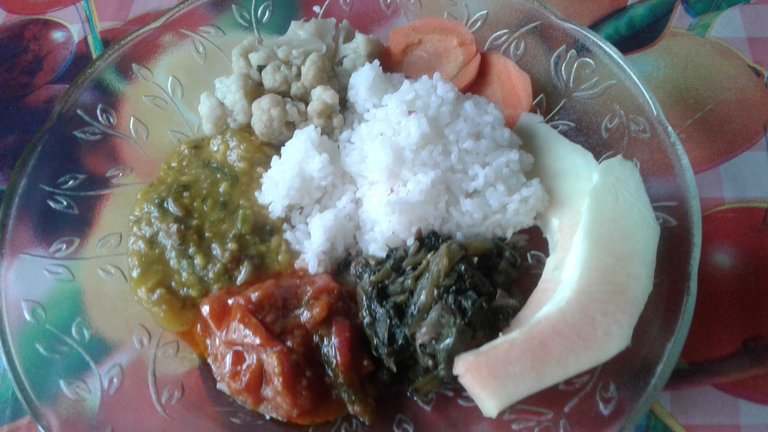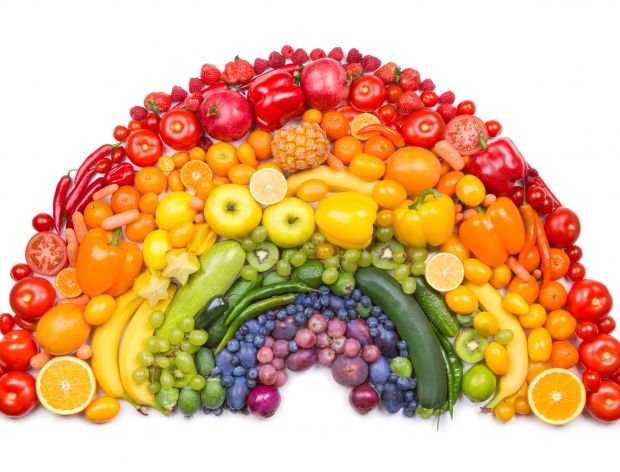Questions may arise how come eating healthy by adding colours? Well, it is saying adding differnt colourful fruits and vegetables on your daily food menu to make it healthier.
.jpeg)
Fruits and vegetables come in different colors and each of these colors is a result of certain antioxidants, phytonutrients and nutrients. So how does one know what color fruit and vegetable to eat? The answer is simple; you must eat “Rainbow colored fruit/vegetable” platter to get all health benefits. The different fruit colors are a result of different pigments and each one of which offers different health benefits. It is generally considered, that darker the color, the greater the health benefit the produce offers. Thus; dark green romaine lettuce will have more nutrition than light green iceberg lettuce, red or sweet potatoes have more health benefits than white potatoes and so on.

Fuits and vegetables generally contain little fat, cholesterol or sodium and provide complex carbohydrates, fiber and nutrients. Most are low in calories, and they contain natural sugar, as opposed to refined sugar, which can cause abrupt fluctuations in your blood sugar level. Different colors indicate different nutrient profiles, so focus on getting a little of each color in your diet every day to maximize the nutritional benefits.
What the different colour means and their benefits:
Red
Red fruits and vegetables, such as raspberries, tomatoes, guava, watermelon, red cabbage, kidney beans, cherries, strawberries and beets, are likely to be rich in the antioxidants lycopene and anthocyanins, according to the U.S. Department of Agriculture. A medium raw tomato provides 3.2 micrograms of lycopene, a carotenoid that helps your body make vitamin A. Although there is no set daily value for lycopene, MayoClinic.com recommends getting 2 to 30 milligrams per day.
Orange and Yellow
Most orange and yellow fruits and vegetables are rich in beta-carotene, which your body converts to vitamin A, a nutrient that not only improves night vision, but also helps keep your skin, teeth and bones healthy. They also contain folate, an antioxidant that prevents neural tube defects in unborn infants. A 2-cup serving of sliced cantaloupe provides 541 micrograms of vitamin A, more than 100 percent of your recommended daily intake of 500 micrograms, and 67 of the 320 micrograms of folate you need each day.
Green
Green vegetables are good for your eyes, bones and teeth, and their vitamin K content helps your blood to clot properly. A 2-cup serving of raw spinach provides 290 of the 90 to 120 micrograms of vitamin K you need each day. These foods' antioxidant vitamins, particularly vitamins C and E, may lower your risk of chronic diseases. They provide the phytonutrients lutein and zeaxanthin, which may protect you from vision loss due to eye diseases such as macular degeneration, according to North Dakota State University.
Blue and Purple
Blue and purple fruits and vegetables contain anthocyanins, natural plant pigments with powerful antioxidant properties that may reduce your risk of cardiovascular disease. They also contain flavonoids and ellagic acid, compounds that may destroy cancer cells, according to the American Institute for Cancer Research. The anthocyanins and ellagic acid in blueberries have been shown to fight cancer cells in the lungs, stomach, breasts and pancreas. Anthocyanins and ellagic acid also show anti-inflammatory properties that may prevent cancers of the esophagus and colon.
White
White fruits and vegetables, including apples, pears, bananas, cauliflower and cucumbers, are high in dietary fiber, helping to protect you from high cholesterol, and antioxidant-rich flavonoids, such as quercetin, which is abundant in apples and pears. They may also lower your risk of stroke, according to a group of Dutch researchers who published a study with the American Heart Association in 2011. After a 10-year diet study, they found that people with a high intake of white fruits and vegetables had a 52 percent lower risk of stroke.

Experts recommend that our diet should consist of rainbow colored fruits and vegetables to get all their health benefits. So, the next time you shop, take a look at your cart. If you see all green colored items from the produce section- like spinach, Green apples, Kiwis etc, go back and swap one of the items for oranges, strawberries or blueberries. There are nearly 4000 phytochemicals available in nature and to get their wonderful health benefits, we need to eat more colored fruits and vegetables daily.
Thanks for reading. I have collected information from many sources and presented in my own style. Its a request to leave a review comment or your suggestion to help me make my posts more attractive. Happy Blogging!
excellent post!
thank you @pipienversioners
Hi! I am a robot. I just upvoted you! I found similar content that readers might be interested in:
http://healthyeating.sfgate.com/benefits-eating-multiple-colored-fruits-vegetables-4676.html
your presentation is very nice... keep going
Thank you mam.
thank you @gaman
thank u! Cheers✌✌